Womans Fashion Shorts With Open Skirt
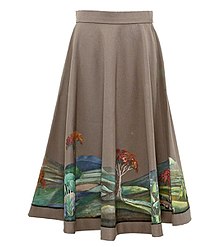 | |
| Blazon | Clothing worn from the waist or hips. |
|---|---|
The Development of the Skirt, Harry Julius, 1916
A skirt is the lower part of a dress or a dissever outer garment that covers a person from the waist downwards.[1]
At its simplest, a skirt tin be a draped garment made out of a single piece of fabric (such equally pareos). Yet, near skirts are fitted to the body at the waist or hips and fuller below, with the fullness introduced past means of darts, gores, pleats, or panels. Modern skirts are usually fabricated of light to mid-weight fabrics, such equally denim, jersey, worsted, or poplin. Skirts of thin or clingy fabrics are often worn with slips to make the material of the skirt drape meliorate and for modesty.
In modern times, skirts are typically worn by women. Some exceptions include the izaar, worn by many Muslim cultures, and the kilt, a traditional men's garment in Scotland, Ireland, and sometimes England. Fashion designers such as Jean Paul Gaultier, Vivienne Westwood, Kenzo and Marc Jacobs have also shown men's skirts. Transgressing social codes, Gaultier oft introduces the brim into his men'southward vesture collections as a ways of injecting novelty into male attire, most famously the sarong seen on David Beckham.[2]
The hemline of skirts can vary from micro to floor-length and can vary according to cultural conceptions of modesty and aesthetics likewise as the wearer's personal taste, which can be influenced by such factors as fashion and social context. Most skirts are self-standing garments, but some skirt-looking panels may be part of another garment such equally leggings, shorts, and swimsuits.
History [edit]
Skirts have been worn since prehistoric times as the simplest manner to cover the lower torso. Figurines produced by the Vinča culture (c.5700-4500 BC) located on the territory of present-day Serbia and neighboring Balkan nations from the start of the copper age bear witness women in skirt-like garments.[3]
A straw-woven skirt dating to 3.900 BC was discovered in Armenia at the Areni-1 cavern complex.[4] Skirts were the standard attire for men and women in all ancient cultures in the About East and Arab republic of egypt. The Sumerians in Mesopotamia wore kaunakes, a type of fur brim tied to a chugalug. The term "kaunakes" originally referred to a sheep's fleece, just somewhen came to be applied to the garment itself. Eventually, the beast pelts were replaced past kaunakes material, a material that imitated fleecy sheep skin.[5] Kaunakes cloth as well served equally a symbol in religious iconography, such equally in the fleecy cloak of St. John the Baptist.[6] [vii]
Ancient Egyptian garments were mainly made of linen. For the upper classes, they were beautifully woven and intricately pleated.[viii] Around two,130 BC, during the Onetime Kingdom of Egypt, men wore wraparound skirts (kilts) known equally the shendyt. They were fabricated of a rectangular piece of cloth wrapped effectually the lower torso and tied in front. Past the Center Kingdom of Egypt, longer skirts, reaching from the waist to ankles and sometimes hanging from the armpits, became fashionable. During the New Kingdom of Arab republic of egypt, kilts with a pleated triangular section became fashionable for men.[nine] Beneath these, a shente, or triangular loincloth whose ends were attached with cord ties, were worn.[10]
During the Statuary Age, in the Southern parts of Western and Central Europe, wraparound dress-like garments were preferred. However, in Northern Europe, people also wore skirts and blouses.[11]
In the Middle Ages, men and women preferred dress-like garments. The lower part of men's dresses were much shorter in length compared to those for women. They were wide cut and frequently pleated or gored then that horse riding was more comfortable. Even a knight'due south armor had a short metal brim beneath the breastplate. It covered the straps attaching the upper legs atomic number 26 cuisse to the breastplate. Technological advances in weaving in the thirteen-15th century, like foot-treadle floor looms and pair of scissors with pivoted blades and handles, improved tailoring trousers and tights. They became fashionable for men and henceforth became standard male attire whilst becoming taboo for women.[12] [13]
Skirts are still worn past men and women from many cultures, such every bit the lungi, lehnga, kanga and sarong worn in Southern asia and Southeast Asia, and the kilt worn in Scotland and Republic of ireland.
1 of the earliest known cultures to have females wear clothing resembling miniskirts were the Duan Qun Miao (短裙苗), which literally meant "brusk skirt Miao" in Chinese. This was in reference to the short miniskirts "that barely cover the buttocks" worn by women of the tribe, and which were probably shocking to observers in medieval and early modern times.[fourteen]
In the Middle Ages, some upper-class women wore skirts over iii metres in diameter at the bottom.[ commendation needed ] At the other extreme, the miniskirts of the 1960s were minimal garments that may take barely covered the underwear when the woman was seated. Costume historians[ who? ] typically use the word "petticoat" to describe brim-like garments of the 18th century or earlier.
-

Sumerian man wearing a kaunakes skirt, ca. 3.000 BC
-

Statue of Ramaat, an official from Gizeh wearing a pleated Egyptian kilt, ca. 2.250 BC
-

Drawing of a girl's brim made of wool yarn establish in a Statuary Age tomb in Borum Eshøj (Danmark)
-

Vinca figurine depicting a skirt
19th century [edit]
During the 19th century, the cut of women'south dresses in western culture varied more widely than in any other century. Waistlines started just below the bust (the Empire silhouette) and gradually sank to the natural waist. Skirts started fairly narrow and increased dramatically to the hoopskirt and crinoline-supported styles of the 1860s; then fullness was draped and drawn to the dorsum by means of bustles. In the 1890s, the rainy daisy brim was introduced for walking or sportswear. It had a significantly shorter hemline measuring as much as vi inches off the ground and would eventually influence the wider introduction of shorter hemlines in the early 20th century.[15]
In the 19th century, in the Us and United Kingdom, there was a movement confronting skirts every bit part of the Victorian wearing apparel reform movement, and in the United States, the National Dress Reform Clan[ citation needed ].
20th and 21st centuries [edit]

After 1915, ankle-length skirts were non more often than not worn in the daytime. For the adjacent fifty years fashionable skirts became curt (1920s), then long (1930s), then shorter (the War Years with their restrictions on fabric), then long (the "New Look"), then shortest of all from 1967 to 1970, when skirts became as short as possible while avoiding exposure of underwear, which was considered taboo.
Since the 1970s and the rise of pants/trousers for women as an option for all just the nearly formal of occasions, no 1 skirt length has dominated way for long, with short and ankle-length styles oftentimes actualization adjacent in fashion magazines and catalogs.
The skirt is a part of uniform for girls in many schools across the earth, with lengths varying depending on local culture. The pleated tartan skirt has been a component of girls' school uniforms since the early on twentieth century in United kingdom of great britain and northern ireland.[16] In the 21st century, skirt has become office of Western dress code for women and is worn as business concern casual and function wearable, and also as sportswear (ex. in tennis). Brim may also be mandatory as formal wearable, such every bit for airhostesses, waitresses, nurses and armed forces women.
Basic types [edit]

A total skirt of blue damask (dorsum). Ethnographic region: Żywiec. Collection of The Land Ethnographic Museum in Warsaw.
- A-line brim
- An a-line skirt is a brim with a slight flare, roughly in the shape of a capital letter A
- Bong-shaped skirt
- A bell-shaped skirt, flared noticeably from the waist just then, unlike a church bong, cylindrical for much of its length
- Circle skirt
- a skirt cutting in sections to make one or more circles with a hole for the waist, and then the skirt is very total simply hangs smoothly from the waist without darts, pleats, or gathers
- Culottes
- A course of divided skirt, divide brim or pantskirt constructed similar a pair of shorts, merely hanging similar a skirt.[17]
- Divided skirt
- See nether: Culottes.
- Full brim
- A skirt with fullness gathered into the waistband
- Gored brim
- A skirt that fits through the waistline and flares at the hem. May be fabricated of from four to twenty-four shaped sections. Dates from the 14th century and much used in the 19th century. Very popular in the late 1860s, mid-1890s, early 20th century, 1930s, 1940s, and now worn as a archetype skirt style.[18]
- Inverted pleated skirt
- A skirt made past bringing two folds of fabric to a center line in front and/ or back. May be cutting straight at sides or exist slightly flared. Has been a bones type of skirt since the 1920s.[eighteen]
- Pleated brim
- A brim with fullness reduced to fit the waist by means of regular pleats ('plaits') or folds, which can be stitched flat to hip-level or costless-hanging
- Curt skirt
- A skirt with hemline above the knee
- Direct skirt
- A Straight brim or Pencil skirt, a tailored skirt hanging direct from the hips and fitted from the waist to the hips past means of darts or a yoke; may have a vent or kicking-pleat ready in the hem for ease of walking
- Underskirt
- Uncomplicated, bones skirt over which an overskirt, or drapery, hangs.[xviii]
- Wrap or wraparound skirt
- A brim that wraps effectually the waist with an overlap of material
Fads and fashions [edit]
- Ballerina skirt
- A Ballerina skirt is a mid-calf full brim popular in the 1950s.
- Broomstick skirt
- A light-weight ankle-length brim with many crumpled pleats formed by compressing and twisting the garment while wet, such as effectually a broomstick. (1980s and on)
- Bubble skirt
- A bubble skirt, as well called tulip skirt or airship skirt, is a voluminous brim whose hem is tucked back under to create a "chimera effect" at the bottom. Popular in the 1950s.[18]
- Cargo brim
- A cargo skirt is a plainly commonsensical skirt with belt loops and numerous big pockets, based on the war machine manner of Cargo pants and popularised in the 1990s.
- Crinoline
- A crinoline is a very full brim supported by hoops or multiple petticoats, popular at various times from the mid 19th century onwards.
- Dirndl
- A dirndl skirt, (durn′del) is a brim in the Bavarian-Austrian dirndl style, fabricated of a straight length of fabric gathered at the waist. The style derives from Tyrolean peasant costume.[18]
- Denim skirt
- A denim skirt (or jeans skirt), is a skirt made of denim, often designed like five-pocket jeans, but found in a large diversity of styles.
- Godet brim
- A godet skirt (go-twenty-four hours') is a brim with triangular pieces of fabric inserted upward from the hem to create more fullness. Popular in the 1930s.[18]
- Hobble skirt
- A Hobble skirt is a long and tight skirt with a hem narrow enough to significantly impede the wearer's stride
- Kilt-skirt
- a wrap-effectually brim with overlapping aprons in front and pleated effectually the back. Though traditionally designed as women'south wear, information technology is fashioned to mimic the general appearance of a human being's kilt.
- Leather skirt
- a skirt fabricated of leather
- Lehenga
- A Lehenga (also Ghagra; Garara ), is a long, pleated skirt, ofttimes embroidered, worn generally as the bottom part of the Gagra choli in North Bharat and Pakistan.[19]
- Maxi skirt
- An talocrural joint-length daytime brim, popular with women in the late 1960s as reaction confronting miniskirts.[xviii]
- Micromini
- an extremely short mini-skirt.
- Mandala brim
- A skirt with a mandala motifs.
- Midi brim
- A skirt with hem halfway between talocrural joint and knee, below the widest part of the calf. Introduced by designers in 1967 every bit a reaction to very brusque mini skirts.[18]
- Mini-crini
- a mini-length version of the crinoline, designed by Vivienne Westwood in the mid 1980s.[twenty]
- Poodle brim
- A Poodle skirt is a circle or about-circle skirt with an appliqued poodle or other decoration (1950s)
- Puffball skirt
- A puffball skirt, besides chosen "puff" or "pouf", is a bouffant skirt caught in at the hem to create a puffed silhouette. Popular in the mid-tardily 1980s when information technology was inspired past Westwood's "mini-crini".[21]
- Rah-rah skirt
- A Rah-rah skirt is a short, tiered, and ofttimes colourful skirt stylish in the early-mid-1980s.
- Sarong
- A Sarong is a foursquare or rectangle of fabric wrapped around the body and tied on i hip to create a brim that can be worn past both sexes
- Samare
- A Samare was a long-skirted jacket, in which a loose jacket with extra frills hung down to the knees in the style of a gown.[22] [23]
- Scooter skirt
- A scooter brim or skort (variant), a skirt that has an attached pair of shorts underneath for modesty. Alternatively, merely with similar effect, a pair of shorts incorporating a skirt-like flap across the front of the body.
- Skater skirt
- a short, high-waisted circumvolve skirt with a hemline above the knee, often made of lighter materials to give the flowing effect that mimics the skirts of figure skaters.
- Squaw dress
- A Squaw dress or fiesta dress is a 1 or two piece outfit based on Native American clothing. Fashionable in the 1940s and 50s.[24]
- Swing skirt
- flared skirt, circular or cut in gores, fitted at hips with a broad flare at the hem. Popular in the tardily 1930s and at interval since. Very popular in the mid-1980s.[xviii]
- T-brim
- A T-skirt is a skirt made from a tee-shirt. The T-skirt is mostly modified to consequence in a pencil brim, with invisible zippers, full length 2-way separating side zippers, equally well as artful fabric overlays and yokes.
- Tiered brim
- a brim fabricated of several horizontal layers, each wider than the one above, and divided past stitching. Layers may await identical in solid-colored garments, or may differ when made of printed fabrics.
- Prairie skirt
- A Prairie skirt, variant of a tiered skirt, is a flared skirt with one or more flounces or tiers (1970s and on)
- Trouser brim
- Trouser skirt or culotte, a straight skirt with the part above the hips tailored like men'south trousers, with belt loops, pockets, and wing front end.
- Tulip brim
- see nether: Chimera skirt.
Lengths [edit]
-
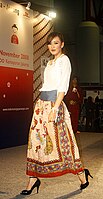
Ankle-length skirt or 'maxi,' a term introduced in the late 1960s
-
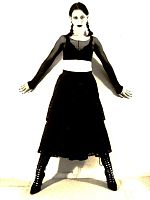
Mid-calf length or 'midi,' a term introduced in the 1970s.
-

Mini-skirt, a skirt catastrophe between knee and upper thigh. (1960s onwards)
-

High-low/hi-lo skirt, a skirt with an asymmetrical hemline.
Male clothing [edit]

There are a number of garments marketed to men which fall under the category of "skirt" or "apparel". These become past a diversity of names and form part of the traditional wearing apparel for men from diverse cultures. Usage varies – the dhoti is office of everyday dress on the Indian subcontinent while the kilt is more than usually restricted to occasional wear and the fustanella is used almost exclusively every bit costume. Robes, which are a type of dress for men, take existed in many cultures, including the Japanese kimono, the Chinese cheongsam, the Standard arabic thobe, and the African Senegalese kaftan. Robes are besides used in some religious orders, such equally the cassock in Christianity and various robes and cloaks that may be used in infidel rituals. Examples of men's skirts and skirt-similar garments from various cultures include:
- The fustanella is a full-pleated skirt worn by men in Albania and Greece and other parts of the Balkans. By the mid-20th Century, information technology was relegated to formalism utilise and as period or traditional costume. It is worn by the Evzones, or Evzoni (Greek: Εύζωνες, Εύζωνοι, pronounced [evˈzones, evˈzoni]), which is the proper noun of several historical elite lite infantry and mount units of the Greek Regular army. Today, it refers to the members of the Presidential Guard who parade the presidential mansion wearing a short version of this historic costume.
- The gho is a knee-length robe worn past men in Bhutan. They are required to wearable it every day equally role of national dress in government offices, in schools and on formal occasions.[25]
- The hakama is worn in Japan. There are 2 types of hakama, divided umanori (馬乗り, "horse-riding hakama") and undivided andon hakama (行灯袴, "lantern hakama"). The umanori type has wide and divided legs, similar to culottes. Some hakamas are pleated.
- The kilt is a skirt of Gaelic and Celtic history, part of the Scottish national dress in particular, and is worn formally and to a lesser extent informally. Irish and Welsh kilts also be but are not so much a role of national identity.
- The sarong is a piece of material that may be wrapped effectually the waist to form a skirt-similar garment. Sarongs exist in diverse cultures under various names, including the pareo and lavalava of the Hawaiian islands and Polynesia (Samoa, Tonga, Tahiti, and Fiji), the Indian dhoti and lungi, and the South Indian and Maldivian mundu.
Bated from the wearing of kilts, in the Western world skirts, dresses, and similar garments are generally viewed exclusively women's wear which, historically, was not ever the case.[26] However, some Western men have taken up skirts equally forms of civil protest.[27] Other Western men advocate skirts as a mensurate of co-equality between women and men.
Gallery [edit]
- Basic types
-

-

Circumvolve
-
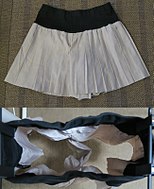
-
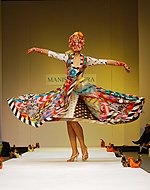
Full (in motility)
-
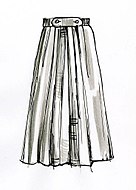
Pleated
-

- Fads and fashions
- Globe culture
See also [edit]
- Trousers
- Victorian dress reform
References [edit]
- ^ "Brim". Oxford English language Dictionary (Online ed.). Oxford University Press. (Subscription or participating establishment membership required.)
- ^ Fogg, Marnie (2011) The Mode Blueprint Directory. London: Thames & Hudson. p.165,316
- ^ Cvekic, Ljilja (12 Nov 2007). "Prehistoric women had passion for manner". Reuters . Retrieved 19 September 2016.
- ^ "5,900-twelvemonth-sometime women's skirt discovered in Armenian cave". News Armenia. September 13, 2011. Retrieved September fourteen, 2011.
- ^ Boucher, Francois (1987): 20.000 Years of Mode: The History of Costume and Personal Adornment. New York: Harry Due north. Abrams
- ^ The Bible: Genesis 12:four-five
- ^ Roberts, J.Thousand. (1998): The Illustrated History of the Earth. Time-Life Books. Book 1. p. 84
- ^ Barber, Elisabeth J.Due west. (1991): Prehistoric Textiles: The Development of Cloth in the Neolithic and Bronze Ages with Special Reference to the Aegean. Princeton: Princeton University Press. p.12
- ^ Rief Anawalt, Patricia (2007): The Worldwide History of Dress. London: Thames & Hudson. p. 25
- ^ Rief Anawalt, Patricia (2007): The Worldwide History of Wearing apparel. London: Thames & Hudson. p. 24
- ^ Koch-Mertens, Wiebke (2000): Der Mensch und seine Kleider: Dice Kulturgeschichte der Style bis 1900. Artemis & Winkler: Düsseldorf Zürich. pp. 49-51
- ^ Tortora, Phyllis G. et. Al. (2014): Dictionary of Fashion. New York: Fairchild Books. p. xi
- ^ Koch-Mertens, Wiebke (2000): Der Mensch und seine Kleider: Die Kulturgeschichte der Mode bis 1900. Artemis & Winkler: Düsseldorf Zürich. pp. 156-162
- ^ Harrell, Stevan (1995). Cultural Encounters on China's Indigenous Frontiers. University of Washington Press. pp. 98 & 103. ISBN0-295-97528-8.
- ^ Colina, Daniel Delis (2007). As seen in Faddy : a century of American fashion in advertising (1. pbk. print. ed.). Lubbock, Tex.: Texas Tech University Press. pp. 23–25. ISBN978-0-89672-616-1.
- ^ Brown, Ian (2010). From Tartan to Tartanry: Scottish Culture, History and Myth, page 177. Edinburgh: Edinburgh Academy Press. ISBN978-0748644490.
- ^ Yarwood, Doreen (2011). Illustrated encyclopedia of world costume. Mineola, N.Y.: Dover Publications, Inc. p. 376. ISBN9780486433806.
- ^ a b c d e f grand h i Tortora, Phyllis Thou. et. Al. (2014): Dictionary of Fashion. New York: Fairchild Books. pp. 370-374
- ^ "Social Science a Textbook in History for Class 9 every bit per New Syllabus". google.co.in.
- ^ Staff writer. "Vivienne Westwood designs". Victoria and Albert Museum. Retrieved five June 2015.
- ^ Evans, Caroline (2004). "Cultural Capital 1976–2000". In Breward, Christopher; Ehrman, Edwina; Evans, Caroline (eds.). The London wait : way from street to catwalk. New Haven: Yale University Press / Museum of London. p. 149. ISBN9780300103991.
- ^ Freeman, Ruth Sunderlin (1978). Cavalcade of Dolls: Basic Source Volume for Collectors. Century House Publishing Company. p. 301. ISBN978-0-87282-001-2.
- ^ McClellan, Elisabeth (1906). Celebrated Dress, 1607-1800: With an Introductory Affiliate on Dress in the Spanish and French Settlements in Florida and Louisiana. Lane. p. 133.
- ^ Driver, Maggie (21 April 2016). "The squaw dress: Tucson'southward controversial but unique fashion history". Arizona Sonora News. Archived from the original on 2018-01-18. Retrieved 2018-01-17 .
- ^ "Gho & Kira: The National Dress". Kingdom of bhutan's Civilization. RAOnline. Retrieved 31 July 2010.
- ^ "The History Of Men & Skirts". Bustle. 22 May 2017. Retrieved 5 October 2018.
- ^ "These Men in Skirts and Dresses Protested Workplace Dress Codes. Lo and Behold, They Won". Bustle. 27 June 2017. Retrieved 5 October 2018.
- Brockmamn, Helen L.: The Theory of Mode Blueprint, Wiley, 1965.
- Picken, Mary Brooks: The Style Dictionary, Funk and Wagnalls, 1957. (1973 edition ISBN 0-308-10052-ii)
- Tozer, Jane, and Sarah Levitt: Textile of Guild: A Century of People and Their Dress 1770–1870, Laura Ashley Ltd., 1983; ISBN 0-9508913-0-4
External links [edit]
| | Wait up brim in Wiktionary, the gratuitous dictionary. |
| | Wikimedia Commons has media related to Skirts. |
| | Wikimedia Eatables has media related to Miniskirts. |
- ApparelSeach glossary of cloth and clothes terms
- An international dress size converter
- New South Korean Law Might Brand Miniskirts Illegal
- France Revokes 214-Year-Old Law That Fabricated It Illegal For Women To Wear Pants

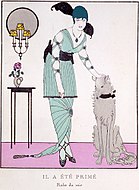


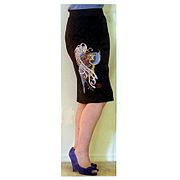


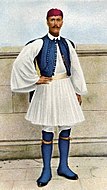
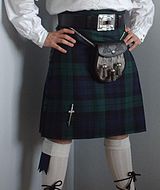



0 Response to "Womans Fashion Shorts With Open Skirt"
Post a Comment